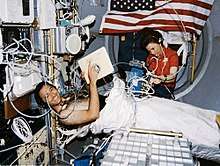Lawrence J. DeLucas
Lawrence James "Larry" DeLucas (O. D., Ph.D.) is an American biochemist who flew aboard NASA Space Shuttle mission STS-50 as a Payload Specialist. He was born on July 11, 1950 in Syracuse, New York, and is currently married with three children. His recreational interests include basketball, scuba diving, bowling, model airplanes, astronomy and reading.
Lawrence DeLucas | |
|---|---|
 | |
| Born | July 11, 1950 |
| Nationality | American |
| Occupation | Biochemist |
| Space career | |
| NASA Payload Specialist | |
Time in space | 13d 19h 30m |
| Missions | STS-50 |
Mission insignia |  |
Education
DeLucas attended the University of Alabama at Birmingham (UAB), in Birmingham, Alabama and received the following degrees:
- Bachelor of Science degree in Chemistry (1972)
- Master of Science degree in Chemistry (1974)
- Bachelor of Science degree in Physiological Optics (1979)
- Doctorate in Optometry (1981)
- Doctorate in Biochemistry (1982)
Organizations
DeLucas has served as a member of the following organizations:
- American Crystallographic Association
- American Academy of Optometry
- American Institute of Aeronautics and Astronautics
- Alabama Optometric Association
- American Association of Pharmaceutical Scientists
- National Aeronautic Association
- Biotechnology Industry Organization
- Biotechnology Association of Alabama
- Helen Keller Eye Research Foundation
Publications
He has published 163 research articles in refereed scientific journals, is co-author of 2 books, and co-inventor on 43 patents.
Honors
- Co-Chair, Spacehab Science Advisory Board
- Secretary of the Board, Council of Biotechnology Centers, Biotechnology Industry Council
- Distinguished Faculty Lecturer, UAB
- Howell Heflin Statesmanship Award for Technology, NASA Space Flight Medal
- Recognized as one of the scientists who could shape the 21st century in an article by The Sunday Times entitled "The Brains Behind the 21st Century"
- Distinguished Crystallography Lecturer for Pittsburgh Diffraction Society Lecturers
- Honorary Doctor of Science degree, The Ohio State University, Illinois College of Optometry, State University of New York State College of Optometry, and Ferris State University, Big Rapids, MI.
- NASA Space Flight Medal; flew as a payload specialist astronaut on the Columbia Space Shuttle, June 25-July 9, 1992. This was the longest space shuttle flight to date making 221 orbits of Earth.
- Served as the NASA Chief Scientist for the International Space Station, at NASA HQ in Washington DC; 1994–1995.
- Received the 1st Distinguished Alumnus Award from the University of Alabama at Birmingham, December 8, 1991.
Experience
- 1975 – 1976: Research Associate in the Institute of Dental Research, UAB
- 1977 – 1982: Graduate Student, working on combined doctoral degrees in Optometry and Biochemistry
- 1982 – 2016: Member of Vision Science Research Center
- 1983 – 2016: Member, Graduate Faculty, UAB
- 1984 – 2016: Scientist, Comprehensive Cancer Center, UAB
- 1986 – 1992: Associate Director, Center for Macromolecular Crystallography, UAB
- 1987 – 2001: Member of NASA Science Advisory Committee for Advanced Protein Crystal Growth
- 1989 – 2016: Adjunct Professor, Materials Science, University of Alabama in Huntsville, University of Alabama at Birmingham, University of Alabama
- 1989 – 2016: Professor, Department of Optometry, UAB
- 1990 – 2016: Adjunct Professor, Laboratory of Medical Genetics, UAB
- 1990 – 2016: Adjunct Professor, Department of Biochemistry, UAB
- 1990 – 2010: Member, Executive Committee and Board of the Helen Keller Eye Research Foundation
- 1994 – 1995: NASA Chief Scientist for International Space Station
- 1994 – 2016: Director, Center for Biophysical Sciences and Engineering, UAB
- 1994 – 2016: Director, Cancer Center X-ray Core Facility, UAB
- 1996 – 2016: Member Research Foundation and Technology Transfer Committee, [[University of Alabama at Birmingham|UAB]]
- 1997 – 1998: Member Metabolic Bone Disease, UAB
- 1997 – 2000: Member, Media Relations Group, UAB
- 2001 – 2016: Adjunct Professor, Physiology and Biophysics
- 2016–present: Principal Scientist, The Aerospace Corporation
Spaceflight

DeLucas was a member of the crew of Space Shuttle Columbia for STS-50 (June 25-July 9, 1992), the United States Microgravity Laboratory-1 (USML-1) Spacelab mission. Over a two-week period, the crew conducted a wide variety of experiments relating to materials processing and fluid physics. At mission conclusion, DeLucas had traveled over 5.7 million miles in 221 Earth orbits, and had logged over 331 hours in space.